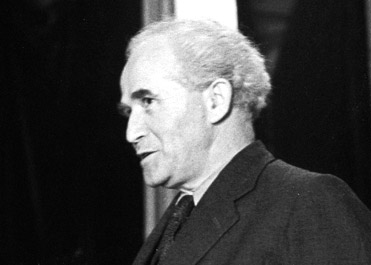The war over, Israel focused on building the state which the people had struggled so long and so hard to regain. The first 120-seat Knesset (parliament) went into session following national elections (25 January 1949) in which nearly 85 percent of all eligible voters cast their ballots.
Two of the people who had led Israel to statehood became the country's leaders: David Ben-Gurion, head of the Jewish Agency, was chosen as the first prime minister; and Chaim Weizmann, head of the World Zionist Organization, was elected by the Knesset as the first president. On 11 May 1949, Israel took its seat as the 59th member of the United Nations.
 David Ben-Gurion, man of vision (GPO/K. Zoltan)
David Ben-Gurion, man of vision (GPO/K. Zoltan)
In accordance with the concept of the 'ingathering of the exiles' which lies at the heart of Israel's raison d'être, the gates of the country were thrown open, affirming the right of every Jew to come to the country and, upon entry, to acquire citizenship. In the first four months of independence, some 50,000 newcomers, mainly Holocaust survivors, reached Israel's shores. By the end of 1951, a total of 687,000 men, women, and children had arrived, over 300,000 of them refugees from Arab lands, thus doubling the Jewish population.
The economic strain caused by the War of Independence and the need to provide for a rapidly growing population required austerity at home and financial aid from abroad.
Assistance extended by the United States government, loans from American banks, contributions of Diaspora Jews and post-war German reparations were used to build housing, mechanize agriculture, establish a merchant fleet and a national airline, exploit available minerals, develop industries and expand roads, telecommunications, and electricity networks.
Towards the end of the first decade, the output of industry doubled, as did the number of employed persons, with industrial exports increasing four-fold. Vast expansion of areas under cultivation had brought about self-sufficiency in the supply of all basic food products except meat and grains, while some 50,000 acres of mostly barren land were afforested and trees were planted along almost 500 miles (800 km.) of highways.
The educational system, which had been developed by the Jewish community in the pre-state period and now included the Arab sector, was greatly expanded. School attendance became free and compulsory for all children aged 5-14 (since 1978 it has been mandatory to age 16 and free to age 18). Cultural and artistic activity flourished, blending Middle Eastern, North African, and Western elements, as Jews arriving from all parts of the world brought with them the unique traditions of their own communities as well as aspects of the culture prevailing in the countries where they had lived for generations. When Israel celebrated its 10th anniversary, the population numbered over two million.
A new immigrant woman sitting with her children on their luggage
at the main square of Yehud (GPO/K. Zoltan)
1956 Sinai Campaign
The years of state-building were overshadowed by serious security problems. The 1949 armistice agreements had not only failed to pave the way to permanent peace, but were also constantly violated.
In contradiction to the UN Security Council Resolution of 1 September 1951, Israeli and Israel-bound shipping was prevented from passing through the Suez Canal; the blockade of the Straits of Tiran was tightened; incursions into Israel of terrorist squads from neighboring Arab countries for murder and sabotage occurred with increasing frequency; and the Sinai peninsula was gradually converted into a huge Egyptian military base.
Upon the signing of a tripartite military alliance by Egypt, Syria and Jordan (October 1956), the imminent threat to Israel's existence was intensified. In the course of an eight-day campaign, the IDF captured the Gaza Strip and the entire Sinai Peninsula, halting 10 miles (16 km.) east of the Suez Canal.
A United Nations decision to station a UN Emergency Force (UNEF) along the Egypt-Israel border and Egyptian assurances of free navigation in the Gulf of Eilat led Israel to agree to withdraw in stages (November 1956 - March 1957) from the areas taken a few weeks earlier. Consequently, the Straits of Tiran were opened, enabling the development of trade with Asian and East African countries, as well as oil imports from the Persian Gulf.
Sinai Campaign 1956